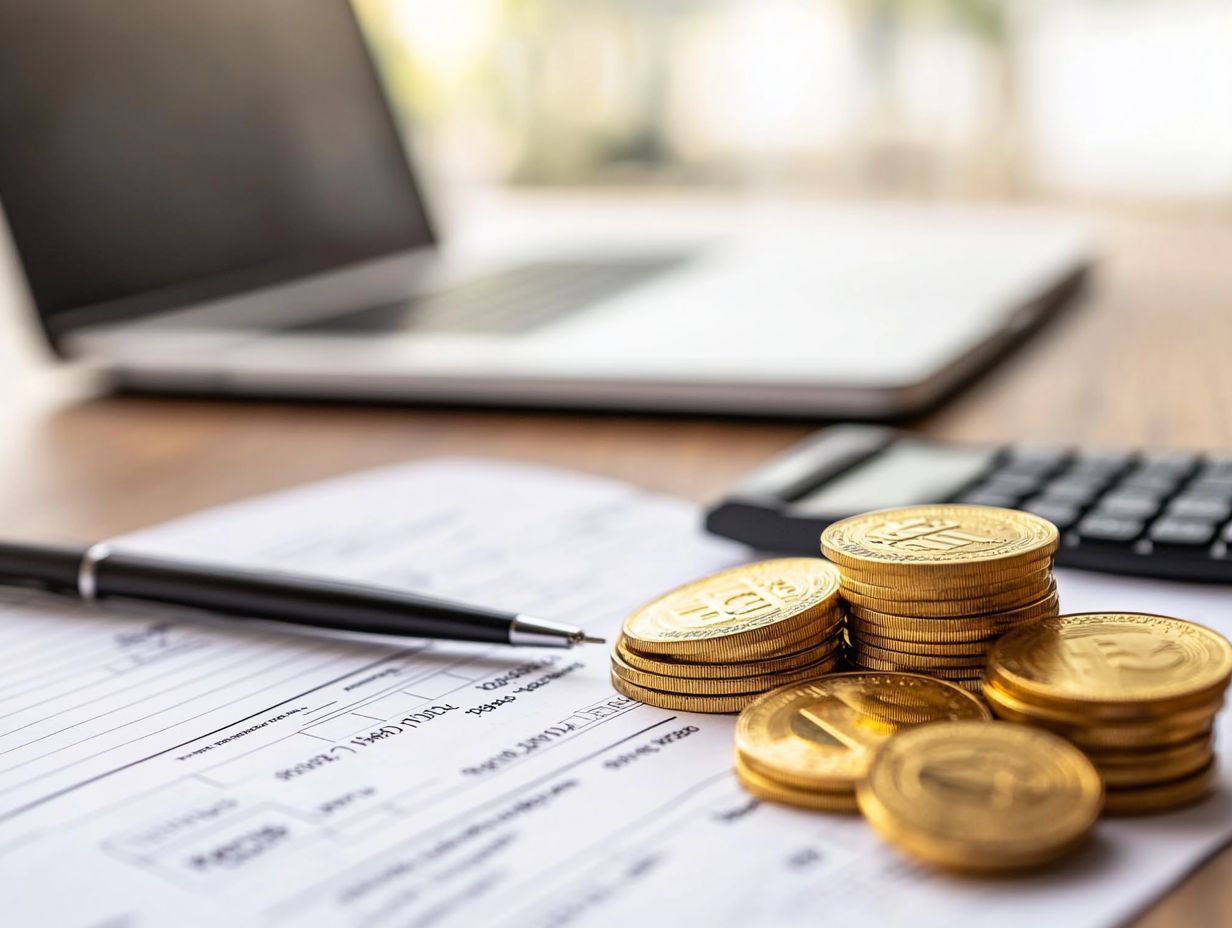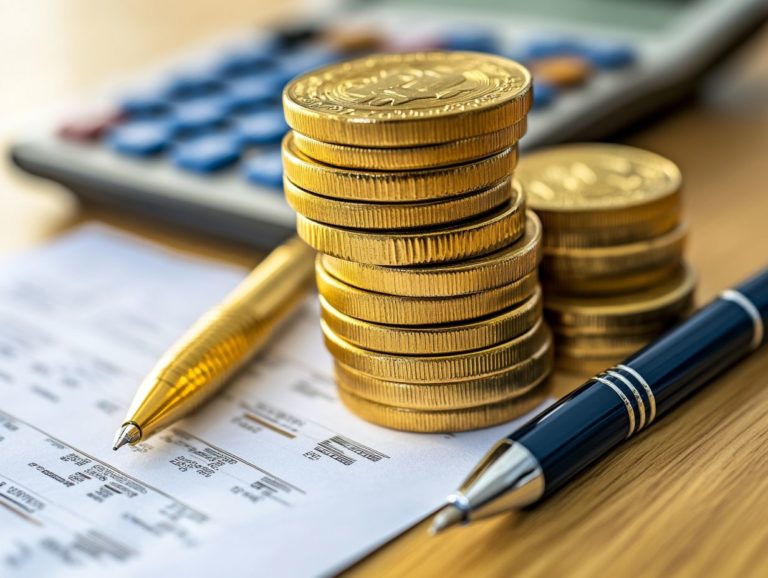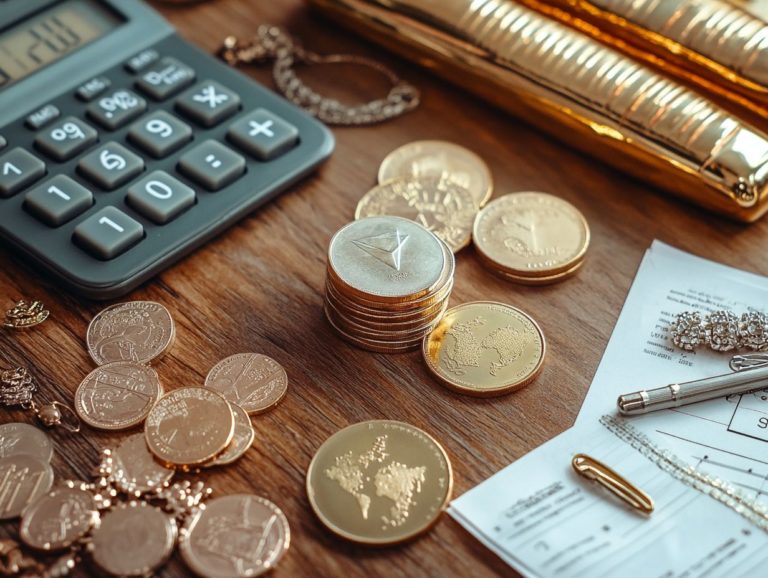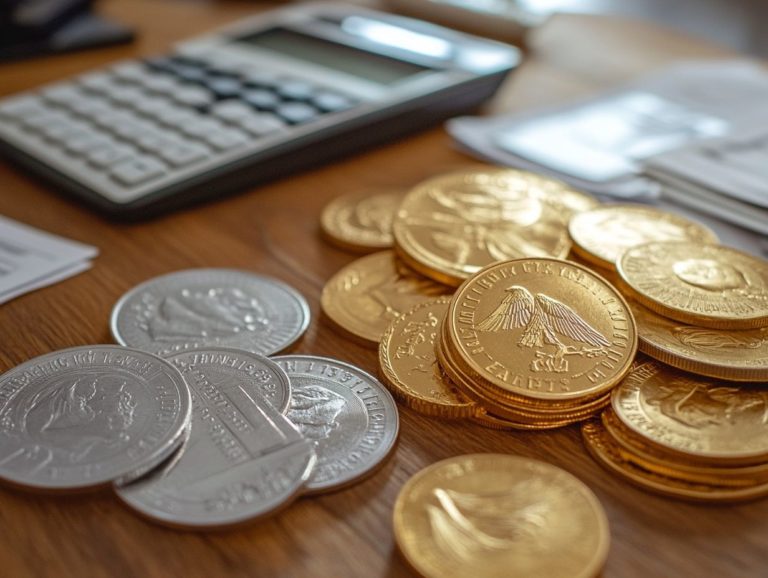Tax Filing Tips for Precious Metals Investors
Investing in precious metals can be a rewarding venture, but it’s essential to grasp the tax implications that come with it.
Get ready to discover essential tips that will transform your tax reporting experience! This guide will provide key information, from how to report your investments on tax returns to uncovering strategies that can enhance your tax benefits.
You’ll also learn about common mistakes that could lead to costly pitfalls, along with resources for tax-filing assistance. Don’t wait to understand these crucial tax aspects. The sooner you learn, the better prepared you’ll be!
Contents
- Key Takeaways:
- Understanding Tax Implications for Precious Metals
- Reporting Precious Metals on Tax Returns
- Tax Strategies for Precious Metals Investors
- Common Mistakes to Avoid
- Resources for Tax Filing Assistance
- Frequently Asked Questions
- What is the tax rate for precious metals investments?
- Do I have to report my precious metals investments on my tax return?
- Can I deduct losses from my precious metals investments on my taxes?
- What forms do I need to report my precious metals investments on my tax return?
- Are there any tax breaks for investing in precious metals?
- What is the best way to keep track of my precious metal investments for tax purposes?
Key Takeaways:
- Understanding the tax implications of precious metals investments is crucial for preventing unexpected tax liabilities.
- When reporting precious metals on tax returns, be sure to use the correct forms and follow all requirements to avoid potential penalties.
- Maximizing tax benefits can be achieved through strategic planning and utilizing resources specifically designed for precious metals investors.
Understanding Tax Implications for Precious Metals
Grasping the tax implications of investing in precious metals like gold and silver is vital for optimizing your financial growth while ensuring compliance with the rules set by the IRS. This involves various factors, including capital gains, tax rates, and specific reporting requirements. Capital gains are the profits made from selling an asset for more than you paid for it, and all these factors can profoundly impact your investment strategy.
Be mindful of how precious metals are classified as collectibles and how this designation influences your tax liability. Understanding the differences between long-term and short-term gains is critical for effective portfolio management and minimizing your tax burdens.
Overview of Taxation on Precious Metals Investments
Taxes on precious metals can be complicated, but understanding them is crucial for your financial success. The taxation landscape is primarily governed by capital gains tax regulations established by the IRS.
Understanding how each metal is treated under tax law can significantly shape your financial strategy. For example, while gold and silver might be viewed similarly due to their historical roles as hedges against inflation, they could face different tax rates upon sale. Platinum adds another layer of complexity due to its unique market status.
Be aware that any gains realized from selling these assets require proper reporting on your tax returns, as the IRS diligently monitors transactions to ensure compliance. Knowing the holding period is imperative; short-term capital gains apply if held for less than a year, while long-term rates might help ease your tax burden.
It’s also essential to keep records of purchase prices, as these will ultimately determine the taxable gain when you decide to sell your assets.
Reporting Precious Metals on Tax Returns
Reporting precious metals on your tax returns is essential for ensuring compliance with IRS regulations. It involves specific forms and documentation, most notably Form 1099-B, which outlines taxable events related to the sale of your precious metals.
By meticulously documenting these transactions, you can navigate the complexities of tax regulations with confidence and precision.
Forms and Requirements
To accurately report your precious metals transactions, familiarize yourself with the various forms and requirements set by the IRS, particularly Form 1099-B, which is essential for declaring your gains or losses.
Beyond just Form 1099-B, you must grasp the nuances of other relevant documents, such as Form 8949, used for reporting sales and exchanges of capital assets—including those precious metals you’re dealing with.
Ensure that every sale or exchange is meticulously documented, capturing vital details like the acquisition date, sale date, and cost basis.
If you find yourself involved in higher-volume trades, be aware that IRS regulations may necessitate additional reporting for transactions that exceed certain thresholds. Keeping meticulous records is key to complying with your tax obligations and reporting standards.
Tax Strategies for Precious Metals Investors
Utilizing effective tax strategies as a precious metals investor can yield considerable financial benefits. This is especially important when navigating profits earned from selling investments, optimizing tax advantages through retirement accounts, and understanding the available tax-deductible options.
By adopting these strategies, you position yourself to enhance your overall financial portfolio.
Maximizing Tax Benefits
Maximizing tax benefits associated with your precious metals investments often means leveraging retirement accounts, like a precious metals IRA (Individual Retirement Account), which can significantly lessen your tax liability.
By placing these tangible assets within a retirement account, you can enjoy tax-deferred growth. This means your wealth can grow faster, as any gains from the sale of investment-grade metals aren’t taxed until you withdraw them. This allows for a more substantial accumulation of wealth over time, as taxes won’t nibble away at your profits each year.
It’s essential to select high-quality metals, such as gold and silver bullion, that meet specific purity standards to ensure compliance and maximize your potential returns.
By strategically diversifying within these accounts, you can mitigate risk and enhance your chances of enjoying a rewarding and secure retirement.
Common Mistakes to Avoid
Understanding the common pitfalls when investing in precious metals is crucial for minimizing tax implications and crafting a robust investment strategy that fosters financial growth.
Being informed positions you to make wiser decisions, ultimately enhancing your financial future.
Potential Pitfalls and How to Avoid Them
Understanding the potential pitfalls of investing in precious metals can protect you from unexpected tax liabilities and financial setbacks, particularly during economic uncertainty.
It’s essential to recognize that misreporting gains can lead to significant penalties. If you don’t accurately document the sale and purchase of these valuable assets, you might face issues. Many investors often grapple with the complexities of tax rates, frequently overlooking the long-term capital gains tax that applies to metals held longer than one year.
If you don’t follow the reporting rules, such as filing Form 8300 for cash transactions exceeding a certain threshold, you might face unnecessary legal headaches. To navigate these challenges effectively, maintain comprehensive records of all transactions, consult with a tax professional who specializes in this area, and learn about the specific tax obligations tied to your investments.
Resources for Tax Filing Assistance
Utilizing available resources for tax filing assistance can greatly alleviate the challenges of reporting your precious metals investments and navigating the intricate IRS regulations surrounding tax returns and deadlines.
By leveraging these resources, you can ensure a smoother, more efficient filing process, allowing you to focus on what truly matters.
Tools and Services for Precious Metals Investors
Investors in precious metals can take advantage of an array of tools and services tailored to streamline your tax filing process and elevate your investment portfolio for optimal financial growth.
You can use specialized software that calculates your tax obligations on gains while delivering easy-to-understand reports. This makes the complexities of taxation much simpler. Consulting with tax professionals who are well-versed in the unique regulations surrounding precious metals can provide invaluable guidance, ensuring you stay compliant and maximize your deductions.
Numerous platforms are available that not only track the market value of various metals but also offer critical insights into price fluctuations. This gives you the power to make informed decisions regarding capital gains and strategically time your sales for the best outcome.
Frequently Asked Questions
For further guidance, consult a tax professional or explore additional resources to enhance your understanding of tax strategies for precious metals investments.
What is the tax rate for precious metals investments?
The tax rate for precious metals investments depends on the type of investment and how long you hold it. Short-term gains, from assets held for less than a year, are taxed at your regular income tax rate. Long-term gains, from assets held longer, are taxed at a lower rate of between 0% and 28%.
Do I have to report my precious metals investments on my tax return?
Yes! You must report all precious metals investments on your tax return. This includes all purchases, sales, and any gains or losses.
Failing to report can lead to penalties and interest, so don’t forget!
Can I deduct losses from my precious metals investments on my taxes?
You can deduct losses from your precious metals investments, but only against gains from other investments. If your losses exceed your gains, you can deduct up to $3,000 per year and carry over any remaining losses to future years.
What forms do I need to report my precious metals investments on my tax return?
The specific forms depend on your investment type. For physical metals, report on Form 8949 and Schedule D. If you invest in ETFs or other funds, your broker will provide you with Form 1099-B.
Are there any tax breaks for investing in precious metals?
Yes! Some self-directed IRAs allow investments in precious metals, offering potential tax breaks. You can also offset some taxes on gains by using losses from other investments.
What is the best way to keep track of my precious metal investments for tax purposes?
Keeping accurate records is crucial for hassle-free tax filing and peace of mind! Track all your investments’ purchase and sale dates, amounts, and prices.
Consider using a spreadsheet or an online tool to simplify the process and ensure accuracy.


















